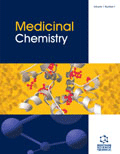To find the most relevant journal, please insert appropriate keyword to facilitate search.
Search Results: mc

Medicinal Chemistry
ISSN: 1573-4064 (Print)
eISSN: 1875-6638 (Online)
Medicinal Chemistry covers all areas of medicinal chemistry, including biological evaluation of novel biologically active compounds, diagnostic agents, or labeled ligands employed as pharmacological tools, structural biological studies using X-ray, NMR, etc. of relevant ligands and biological targets, aiming at the investigation of molecular recognition processes involved in the action of bioactive compounds. The journal also covers chemical and analytical techniques used in rational drug design, synthetic chemistry, bioorganic chemistry of small molecules and naturally occurring compounds, structural characterization, drug-likeness, optimization of structure and properties, the effect of molecular structure on the distribution, pharmacokinetics, and metabolic transformation and toxicology of bioactive compounds including design, synthesis, and evaluation of novel types of prodrugs, quantitative structure-activity relationships, modelling studies, docking studies, new and emerging drug targets, pharmacogenomics, high-throughput screening, and combinatorial chemistry.
Medicinal Chemistry is an essential journal for all researchers involved in drug design and discovery.
Special Issues With Active Call for Papers
Submission closes on: Jun 15, 2024
Recent Advances in the Medicinal Chemistry of Cancer
Scope of the Thematic Issue: Correlation between structure and function is one of the important aspects of the success of anti-cancer compounds associated with their structure-activity interactions, physiology, biochemical, molecular, and genetic processes. Overcoming these obstacles is key to obtaining further insights into developments in rational drug design, bioorganic chemistry, high-throughput screening, combinatorial chemistry for new drug targets with molecular docking or computational-aimed drug design, drug absorption, drug distribution, metabolism, bioinformatics, pharmacogenomics, chemoinformatic, natural products... see more